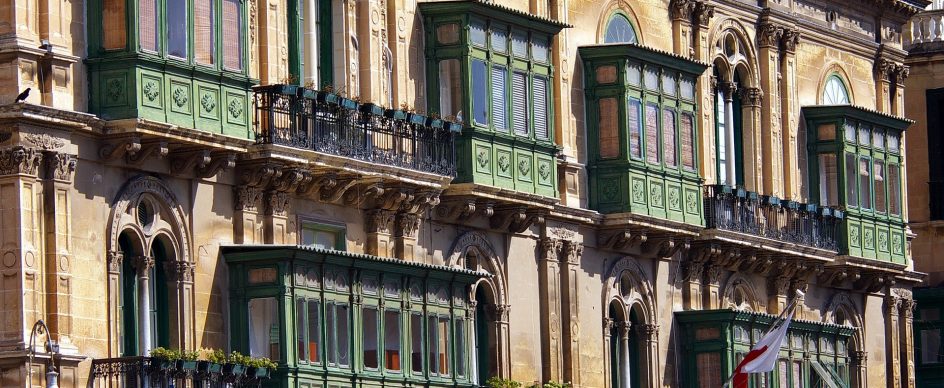
Architectural Maltese Icons – Patterned Tiles & Wooden Balconies
- Mar 30, 2019
The Maltese islands are a cultural melting point with historical influences from Asia to Africa and across Europe...
Malta and Gozo islands have their signature look – it is literally a cultural melting point with historical influences from Asia to Africa and across Europe. The architecture of the archipelagos inside and out, reflects these influences and adds undoubtedly to the warmth of life on these sunshine isles. Maltese Patterned Tiles These beautifully vibrant Maltese tiles are practically a moniker of Malta on every old house from town to town across the islands. They can be distinguished from other tiles due to their very particular palette of colours and geometric patterns. The origins of these tiles can be traced back to Turkey during the reign of the Ottoman empire via Spain, and then on to Malta. The production technique in Malta, however, is a relatively young practice dating back only around 300 years. The traditions of this trade, like many others across the islands, have been passed from generation to generation through the family lines. The dedicated craftmanship behind the making of traditional Maltese tiles is still very much alive though sadly dwindling due to the competition from mass produced techniques such as ceramic tiles. The process to create these old-world Maltese masterpieces is incredibly time-consuming and this therefore results in a product that is of high cost but high quality and value too. Even a master of this craft will only be able to produce three metres of tiles a day, with little to no machinery involved, as the process is more or less done by hand from start to finish. The tiles are made from a mix of cement, marble dust and coloured pigment to give them the stunning vibrancy that graces the floor of many an elegant townhouse. The tiles being effectively made of cement make them incredibly hard wearing too which is possibly why they are still very much in demand in hardworking farmhouses to this day. Many of the designs in production now are the same as those used 100s of years ago and the colour schemes that were in vogue then, still are now too, with the most popular colours being green, red, black and grey. The history of the design’s lives on as well in the names given to the different tiles which are really of their time such as‘Il-bettiegħa’, the melon, ‘Għajnil-baqra’, the cow’s eye, and ‘Sieq it-tiġieġa’, the hen’s leg. These tiles and their unusual names are despite the cost and the competition from cheaper more modern techniques still sought after in Malta and beyond with a healthy export market, as the fashion for a rustic and homely chic continues to thrive. Wooden Balconies Of Malta The wooden balconies of Malta very much define the urban landscape, through the myriad of colours that grace the skyline. The most prominent colour choice is bright emerald green and the enclosed wooden balconies that are scattered across the islands offer the residents the ideal opportunity to people watch as the world passes by under their feet. Due to the abundancy of the closed balconies across the island the people of Malta tend to take them for granted. During a period of modernisation which took Malta and Gozo by storm from the 1960s to the 1990s the closed balcony was almost lost to the architectural landscape of the island and replaced by unsightly stone terraces and even aluminium cladding.
Common sense has long since prevailed and fashion has seen the reinstatement of the traditional wooden balcony. It is once again held up as the architectural icon that it truly deserves to be. The enclosed balcony is believed to date back to the Middle Ages and be derived from the Islamic ‘muxrabija’ which means ‘spy hole’. Older muxrabija in Malta were made from stone, of which a handful of still exist to this day, including one in Triq tal-Karmnu in Victoria, Gozo, in what used to be the Arab quarters. The extensive use of enclosed wooden balconies is believed to have started in the capital Valletta at the end of the 17th century, as the baroque influence arrived at the islands shores from mainland Europe. The balcony from this point rapidly came to symbolise the standing of the owner in society. The earliest examples of baroque balconies are believed to be the ones that adorn the President’s Place overlooking St. George’s Square. These are thought to date back to 1741, and then there is the balcony of Palazzo Bonici which was completed two years earlier in 1739 and is now part of the beautiful Manoel Theatre. It however wasn’t enough that the enclosed balcony itself became an architectural wonder. The stone supports tell their own story too – as one of the many building regulations laid down by the Knights of St. John, the founding fathers of Valletta – stated that the corners were required to have sculptural ornamentation. From this there came the marriage of functionality and design with supports being lavishly decorated with carved faces with outstretched tongues which also served the purpose of warding off the evil eye. By the middle of the 18th century the islands saw smaller wooden balconies start to appear even upon the most modest houses. It became so fashionable that it was given the name La Maltifa (the Maltese). Malta it seemed had claimed the balcony to be its very own creation. As timber, through Malta’s close links to Empire, became cheaper under British rule the balcony became even more ubiquitous as more properties acquired their own look out on the world below. Sight Seeing Maltese Architecture – Why You Should Visit Casa Ellul Boutique Hotel The city of Valletta is rich in architectural gems from grand palaces to timelessly elegant townhouses. Casa Ellul, now a luxury boutique hotel in the heart of Valletta, was originally built around the 1830s. The beautiful old baroque Maltese palazzo situated on Old Theatre Street and overlooking the Manoel Theatre, is adorned with Maltese wooden balconies. A stay in suite 3 and 5 will afford you the view of Valletta from your very own La Maltifa! The footprints of the generations fall upon the beautifully cooling traditional tiles which are to be enjoyed in suites 1 and 4 along with many other interior design gems from back in time. Steeped in history inside and out the old house of the Ellul family is truly a Maltese home from home – when your feet step upon the traditional Maltese tiles and you view the world through the looking glass of the enclosed balcony, you can practically sense history around you.




